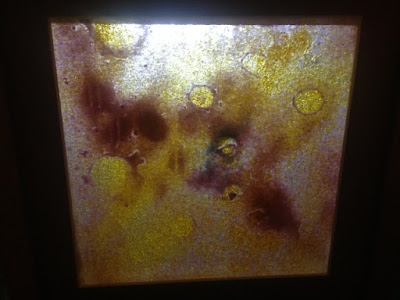I
added a Skutt Firebox kiln to my studio a while ago for hot combing and
vitrigraphy but have only recently found a suitable stand for the latter. I had
thought of using two tables and some concrete blocks to raise the kiln up but
it was never going to work in my studio (ie the laundry!!)
Finally
I bought a set of stainless steel shelves from Brayco. The uprights are 1.8m
and the kiln sits on a shelf 1m above the ground. The central section of the
shelf is cut out to allow the glass to fall onto a second shelf holding a
stainless steel bowl.
The
kiln base is removed and placed on a piece of 2.5cm fibre board with a 2cm hole
cut in the middle. The scrap glass is cut into 2cm squares and put in a 15cm
terracotta pot (the expensive Italian one) and the pot is put on two mullite
strips to raise it off the fibre board. For the first run I did not enlarge the
(drainage) hole in the pot but it might be worthwhile for the future.
I
chose to use an ultra conservative firing schedule –
1
hour to 320°C
4
hours to 740°C
1
hour to 1040°C at which point glass began to flow.
The
Firebox doesn’t have a programmable controller and the ‘heat’ switch is described as
‘infinite’. That means at setting 1 ½ the element heats at about 180°C per hour and 300°C at setting 4. The
switch design means a lot of trial and error and I figured I would rather go
slow and steady to avoid stressing the terracotta pot more so than the glass.
Recommended
schedule is 250°C per hour to 940°C (about 3 ¾ hours).
The thermocouple pyrometer though is reading from close to an element and the
glass in the terracotta pot is insulated. Next time I will try to try 250°C per hour for 4 hours
and see what happens.
When
the temperature reaches 940°C the glass is molten and starts
to flow through the pot’s hole. The temperature has to be raised and lowered to
get the glass streamers to thicken and thin. I used some steel salad servers to
manipulate the streamers and scissors to cut the flow. The streamers fall into
the steel bowl filled half full with vermiculite. The streamers don’t need to
anneal but the vermiculite gives some insulation to slow the cooling somewhat.
The
great things about a vitrigraph kiln are that you can make customized elements
for use in other work and use up scrap glass in any colour combination you
like. I used Spectrum 96 white, cream, grey and pink as I wanted to produce
elements that resemble ghost gum bark. It is also a way of using a kiln to
replicate what is usually done in a hot glass studio so you can produce rods,
stringers and murrini rods.
So,
all in all a great trial run and I will definitely be doing it again.
One
technique for the future would be to let the molten glass to flow straight into
a steel bucket of cool water. The glass should fracture from heat shock and
create customized colour combination frits.






